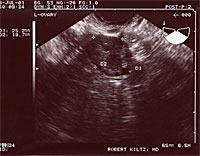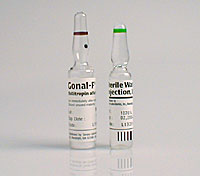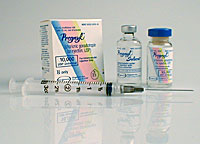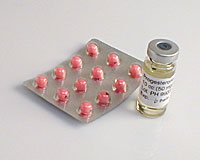Gonadotropins Process

Although the gonadotropin medication regimen may seem complicated and perhaps even confusing, it is a fairly easy process once you understand the steps, methods and effects.
Injection Technique
 Several days before the first treatment cycle, you and your partner need to learn the proper technique for giving intramuscular and subcutaneous injections. You can borrow a VHS video tape demonstrating the injection technique from our office. It is not a difficult procedure to learn and can be mastered quickly. Our Nurse Coordinator can supervise your first injection and answer any questions.
Several days before the first treatment cycle, you and your partner need to learn the proper technique for giving intramuscular and subcutaneous injections. You can borrow a VHS video tape demonstrating the injection technique from our office. It is not a difficult procedure to learn and can be mastered quickly. Our Nurse Coordinator can supervise your first injection and answer any questions.
Baseline Ultrasound
 Gonadotropin injections are usually started about two to three days after you begin menstruating. On the first day of your period, you need to call our office to schedule a baseline ultrasound to detect any preexisting ovarian cysts. Ovarian cysts are very common, are often cyclical and usually resolve on their own. However, if a cyst is found, your treatment cycle may be altered or delayed. A vaginal probe is used for the ultrasound and is harmless to you and your developing eggs.
Gonadotropin injections are usually started about two to three days after you begin menstruating. On the first day of your period, you need to call our office to schedule a baseline ultrasound to detect any preexisting ovarian cysts. Ovarian cysts are very common, are often cyclical and usually resolve on their own. However, if a cyst is found, your treatment cycle may be altered or delayed. A vaginal probe is used for the ultrasound and is harmless to you and your developing eggs.
Injections for Egg Development
 After the baseline ultrasound, you will be instructed when to begin your injections. Each woman’s protocol, start date, dosage and length of treatment is unique and individual to her. Typically you will be on the injections for three to five days before coming back into our office for your next ultrasound to evaluate follicular response. You may also have a blood test to measure the hormone estradiol which is secreted by the growing follicles. The ultrasound/blood test is important not only to measure your progress, but also to monitor your ovaries for any abnormalities due to hyperstimulation. At the time of this ultrasound, you will be given instructions regarding injection dosage for that evening, the next day and schedule a time for your next ultrasound and blood test.
After the baseline ultrasound, you will be instructed when to begin your injections. Each woman’s protocol, start date, dosage and length of treatment is unique and individual to her. Typically you will be on the injections for three to five days before coming back into our office for your next ultrasound to evaluate follicular response. You may also have a blood test to measure the hormone estradiol which is secreted by the growing follicles. The ultrasound/blood test is important not only to measure your progress, but also to monitor your ovaries for any abnormalities due to hyperstimulation. At the time of this ultrasound, you will be given instructions regarding injection dosage for that evening, the next day and schedule a time for your next ultrasound and blood test.
Egg Release
 The follicles, the fluid filled sacs containing the eggs, are visualized and measured by ultrasound. Depending on the follicle growth and estradiol levels, variable doses of gonadotropins (FSH) are given for an additional three to seven days. When the ultrasound and blood tests indicate that the follicles are mature and ready to release the eggs, a single injection of human Chorionic Gonadotropin (hCG; brand names are Pregnyl or Profasi though generic is suitable) is given to induce ovulation – the release of the eggs. hCG is a natural hormone produced by the placenta and is similar to the LH hormone released monthly by the pituitary gland. Egg retrieval is usually thirty six hours after this hCG injection. Intercourse should be avoided during this period.
The follicles, the fluid filled sacs containing the eggs, are visualized and measured by ultrasound. Depending on the follicle growth and estradiol levels, variable doses of gonadotropins (FSH) are given for an additional three to seven days. When the ultrasound and blood tests indicate that the follicles are mature and ready to release the eggs, a single injection of human Chorionic Gonadotropin (hCG; brand names are Pregnyl or Profasi though generic is suitable) is given to induce ovulation – the release of the eggs. hCG is a natural hormone produced by the placenta and is similar to the LH hormone released monthly by the pituitary gland. Egg retrieval is usually thirty six hours after this hCG injection. Intercourse should be avoided during this period.
Progesterone Supplementation
 After the eggs are inseminated, many patients receive progesterone in the form of injections, vaginal suppositories, vaginal cream or oral pills. Progesterone helps develop the lining of the uterus to allow the embryos to implant. If you are on progesterone, your menstrual cycle may be delayed even if you do not become pregnant. If your period is more than two to three days late, you should schedule a blood pregnancy test before stopping any progesterone supplementation.
After the eggs are inseminated, many patients receive progesterone in the form of injections, vaginal suppositories, vaginal cream or oral pills. Progesterone helps develop the lining of the uterus to allow the embryos to implant. If you are on progesterone, your menstrual cycle may be delayed even if you do not become pregnant. If your period is more than two to three days late, you should schedule a blood pregnancy test before stopping any progesterone supplementation.

